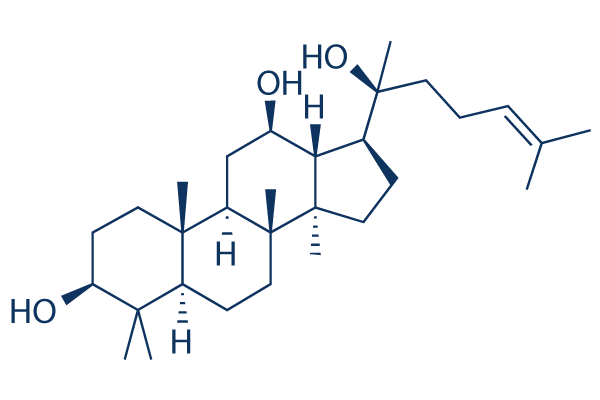|
受注:045-509-1970 |
技術サポート:[email protected] 平日9:00〜18:00 1営業日以内にご連絡を差し上げます |
化学情報

|
Synonyms | 20-Epiprotopanaxadiol | Storage (From the date of receipt) |
3 years -20°C powder 1 years -80°C in solvent |
| 化学式 | C30H52O3 |
|||
| 分子量 | 460.73 | CAS No. | 30636-90-9 | |
| Solubility (25°C)* | 体外 | DMSO | 92 mg/mL (199.68 mM) | |
| Ethanol | 33 mg/mL (71.62 mM) | |||
| Water | Insoluble | |||
|
* <1 mg/ml means slightly soluble or insoluble. * Please note that Selleck tests the solubility of all compounds in-house, and the actual solubility may differ slightly from published values. This is normal and is due to slight batch-to-batch variations. |
||||
溶剤液(一定の濃度)を調合する
生物活性
| 製品説明 | 20(S)-Protopanaxadiol (PPD, 20-Epiprotopanaxadiol), the main intestinal metabolite of ginsenosides, is one of the active ingredients in ginseng. 20(S)-Protopanaxadiol inhibits P-glycoprotein in multidrug resistant cancer cells. |
|---|---|
| in vitro | Concentrations causing growth inhibition of 50% of cells (LC50) for the compounds PPD is 23 μg/ml, for Int-407 cells. The the LC50 for PPD is determined to be 24 μg/ml in Caco-2 cells. In the Int-407 cell line, PPD produces great percentage of sub-G1 (apoptotic) cells(The Int-407 cell line is a human embryonic nonmalignant cell line originating from fetal tissue of approximately 2 months gestation, whereas Caco-2 is a human colon adenocarcinoma cell line). This response is attributed to differences in individual ginsenoside glycosylation and, thus, the hydrophobic-hydrophilic balance [2]. Incubation with PPD also significantly reduces the viability of U251-MG and U87-MG cells in a dose- and time-dependent manner. The cytotoxic effect of PPD is accompanied by reduced expression of cell adhesion proteins, including N-cadherin and integrin β1, which leads to reduced phosphorylation of focal adhesion kinase. Furthermore, incubation with PPD reduces the expression of cyclin D1 and subsequently induces cell-cycle arrest at the G1 phase[3]. |
| in vivo | Treatment with PPD(20(S)-Protopanaxadiol) and PPT(20(S)-Protopanaxatriol) prior to immobilization stress increase the time spent in open arms and open arm entries in the elevated plus-maze (EPM) test. Treatment with PPD potently suppresses immobilization stress-induced serum levels of corticosterone and interleukin (IL)-6 by the enzyme-linked immunosorbent assay. PPD and PPT may exhibit the anxiolytic effect via γ-aminobutyrateA (GABAA) receptor(s) and serotonergic receptor(s), respectively, and PPD may have an anti-inflammatory effect that is more potent than that of PPT[1]. |
プロトコル(参考用のみ)
| 細胞アッセイ | 細胞株 | Int-407 and Caco-2 cell lines |
|---|---|---|
| 濃度 | 23 μg/ml(Int-407 cells); 24 µg/mL(Caco-2 cells) | |
| 反応時間 | 24, 48, 72 h | |
| 実験の流れ | Int-407 and Caco-2 cells are seeded at a concentration of 1×106 cells/mL in 24-well plates in separate experiments. Test ginsenosides (PPD, PPT, Rh2) are added to wells to the LC50 concentration determined previously from the MTT assays. The ginsenoside concentrations used for Int-407 cells are 23, 26, and 53 µg/mL, respectively, for PPD, PPT, and Rh2. In a similar experiment using Caco-2 cells, 24 µg/mL for both PPD and PPT and 55 µg/mL for Rh2 is used. Untreated cells represented the control. Cells are incubated at 37℃ in a 5% CO2 humidified incubator for 24, 48, and 72 h. Cell-free supernatant are obtained by centrifugation(400g) for 10 min, and the lactate dehydrogenase (LDH) assay is conducted as previously reported. |
|
| 動物実験 | 動物モデル | Male ICR mice |
| 投薬量 | 5 or 10 mg/kg | |
| 投与方法 | p.o. |
参考
長期の保管のために-20°Cの下で製品を保ってください。
人間や獣医の診断であるか治療的な使用のためにでない。
各々の製品のための特定の保管と取扱い情報は、製品データシートの上で示されます。大部分のSelleck製品は、推薦された状況の下で安定です。製品は、推薦された保管温度と異なる温度で、時々出荷されます。長期の保管のために必要とされてそれと異なる温度で、多くの製品は、短期もので安定です。品質を維持するが、夜通しの積荷のために最も経済的な貯蔵状況を用いてあなたの送料を保存する状況の下に、製品が出荷されることを、我々は確実とします。製品の受領と同時に、製品データシートの上で貯蔵推薦に従ってください。
